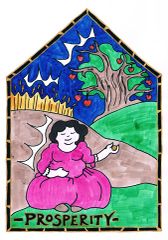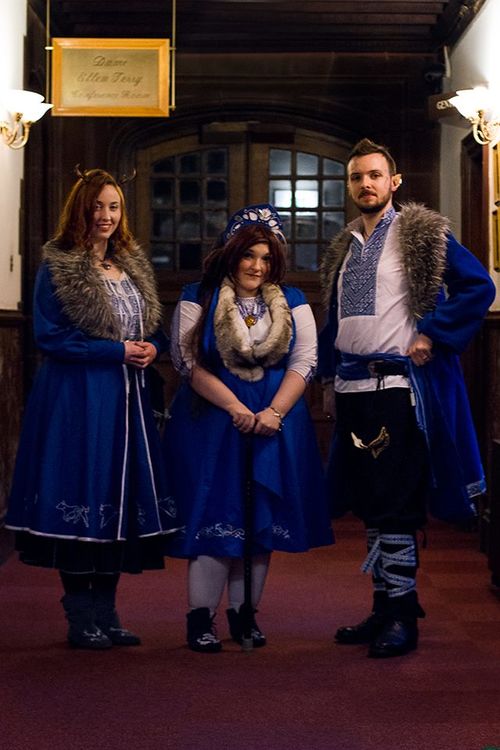Prosperity
The Path of Prosperity
To the one without virtue, Prosperity is oft misunderstood as the pursuit of wealth and luxury, yet neither the wealthy miser, gluttonous sot, or lucky gambler can truly be called prosperous. True Prosperity is the culmination of effort and labour, sweat and toil, and celebrating the fruits of that labour. The prosperous are: the farmer who toils to bring in the harvest and enjoys their bounty; the magician who strives to master a magic and then uses their newfound art; the merchant who competes fiercely for each coin they earn and then spends it in celebration. True Prosperity enriches those around them as well as the individual, and so what may seem the pursuit for the sake of the self is to the benefit of the many.
Guidance on the Path
Through meditation on the auras of Prosperity, and careful study of the tales of paragons and exemplars, the priests of the Way have gleaned insight into the heart of the virtue and how best to pursue it. There are collections of parables, tales, sayings and teachings that distil this for Imperial citizens to learn from. The following are a handful of teachings and sayings deemed to be essential to understanding the path:
- Strive, toil, and claim the just rewards of your labours.
- Enjoy the fruits of your labour today; no one knows what the morrow holds.
- There are three things that should never be made: Food that goes uneaten, coin that goes unspent and magic that goes unused.
- The Prosperous are not selfish; all that is worthwhile is shared with those who deserve it.
- Despise the thieving bandit, the lazy wastrel, the grasping miser, and those who take without giving.
Paragons and Exemplars
Paragons and exemplars of Prosperity are considered reasonably easy to identify owing to their efforts and labour, and how they use - or share - the fruits of those labours. Recognised paragons and exemplars of Prosperity include:
- The legendary paragon Good Walder of the Marches.
- The exemplar known as The Little Mother, whose tireless work helped to establish the importance of charitable deeds in The League.
- The exemplar Long Tom Goodfellow, the healer and brewer whose legacy still encourages pilgrimages today.
- The exemplar Zemress, the Blade of the Isles, who not only encouraged hard work and investment but also the importance of taking-up of arms to defend what is yours.
Symbols of Prosperity
There are a great many symbols of Prosperity across the Empire but one of the most common is the wheatsheaf. Strongly symbolic of harvest time, it represents both the hard work that has gone into ploughing, sowing, and tending the field and the reward for that labour. Priests and pilgrims of this path often have a stalk of wheat or other grain upon them. There are a number of other popular symbols along the same lines, associated with different harvests and different forms of work - the apple, the grape, the fishing net, the wagon, and the merchant ship for example.
Likewise, the coin is a popular representation of Prosperity - sometimes an Imperial crown, sometimes a gold or silver coin stamped with another symbol of prosperity of some sort. As a symbol the coin has grown with prominence through the Empire's history, and is very popular with those whose hard work involves trade or the practice of a profession rather than manual labour. By a similar token a set of artisan's tools are sometimes used as a symbol of the virtue - and in the Marches, a spade or a shovel may stand as a slightly tongue-in-cheek symbol of Prosperity. Another popular symbol in the Marches is the handshake, often used to seal an agreement that will bring Prosperity to both parties.
The cup (along with the wineskin and the waterskin) has a long tradition of being associated with Prosperity. Sometimes it is a cup of water used to quench thirst brought on by hard work, sometimes it is a cup of wine or beer drunk as a reward for a job well done. It is quite common for priests and pilgrims of the Path of Prosperity to carry waterskins, or bear fruit or other food, to enjoy or share as virtue guides them.
A less common symbol of Prosperity is the stout club or cudgel. Possibly a reference to Good Walder, it represents the will to defend what one has earned against the greedy. In some old versions of this symbol, the club is wound with ivy or with thorned berry-bearing briars.
In Wintermark Prosperity is symbolised by the magpie, while in Varushka the virtue is demonstrated by the industrious bee. Some magicians use the rune of Wealth, Pallas, which is said to represent an apple tree, as a symbol of Prosperity.
During their Spring festival, the Urizen use yellow or golden flowers to represent Prosperity.
Further Reading
- You can learn about the various spiritual roleplaying effects created by priests dedicated to Prosperity here.
- You can learn about the skills that priests can use to support the virtue of Prosperity here.

